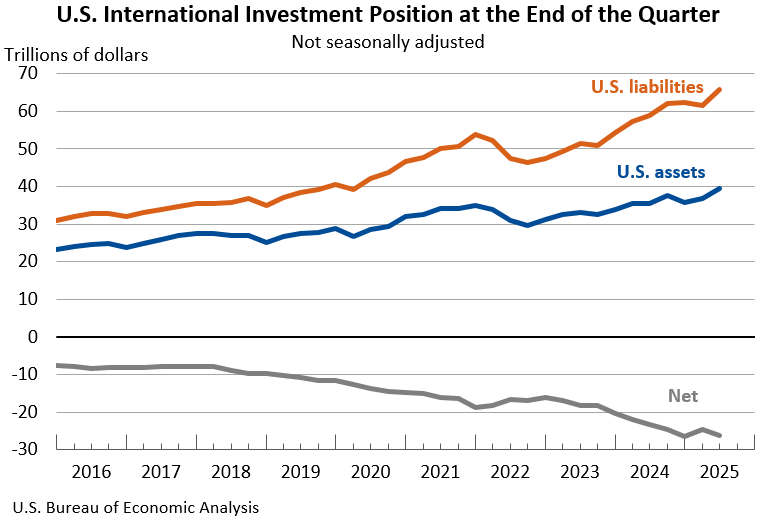Notice
Due to a lapse in appropriations, this website is not being updated.
Bureau of Economic Analysis
U.S. International Investment Position, 2nd Quarter 2025
The U.S. net international investment position, the difference between U.S. residents’ foreign financial assets and liabilities, was -$26.14 trillion at the end of the second quarter of 2025, according to statistics released today by the U.S. Bureau of Economic Analysis. Assets totaled $39.56 trillion, and liabilities were $65.71 trillion. At the end of the first quarter, the net investment position was -$24.65 trillion (revised).
Principal Federal Economic Indicators
Noteworthy
The Latest
2020 Trade Gap is $678.7 Billion
The U.S. international trade deficit increased in 2020 according to the U.S. Bureau of Economic Analysis and the U.S. Census Bureau. The deficit increased from $576.9 billion in 2019 to $678.7 billion in 2020, as exports decreased more than imports. As a percentage of U.S. gross domestic product, the goods and services deficit was 3.2 percent in 2020, up from 2.7 percent in 2019. The goods deficit increased from $864.3 billion in 2019 to $915…
December 2020 Trade Gap is $66.6 Billion
The U.S. monthly international trade deficit decreased in December 2020 according to the U.S. Bureau of Economic Analysis and the U.S. Census Bureau. The deficit decreased from $69.0 billion in November (revised) to $66.6 billion in December, as exports increased more than imports. The previously published November deficit was $68.1 billion. The goods deficit decreased $2.8 billion in December to $84.2 billion. The services surplus decreased…
U.S. International Trade in Goods and Services, December 2020
The U.S. monthly international trade deficit decreased in December 2020 according to the U.S. Bureau of Economic Analysis and the U.S. Census Bureau. The deficit decreased from $69.0 billion in November (revised) to $66.6 billion in December, as exports increased more than imports. The previously published November deficit was $68.1 billion. The goods deficit decreased $2.8 billion in December to $84.2 billion. The services surplus decreased $0.…
Personal Income and Outlays, December 2020
Personal income increased 0.6 percent (monthly rate) while consumer spending decreased 0.2 percent in December as many provisions of the CARES Act continued to wind down before the Coronavirus Response and Relief Supplemental Appropriations (CRRSA) Act was enacted on December 27, 2020. Additionally, new restrictions and closures took effect in some areas of the United States.
Personal Income and Outlays, December 2020
Personal income increased 0.6 percent (monthly rate) while consumer spending decreased 0.2 percent in December as many provisions of the CARES Act continued to wind down before the Coronavirus Response and Relief Supplemental Appropriations (CRRSA) Act was enacted on December 27, 2020. Additionally, new restrictions and closures took effect in some areas of the United States.
Gross Domestic Product, Fourth Quarter and Year 2020
Real gross domestic product (GDP) increased at an annual rate of 4.0 percent in the fourth quarter of 2020, reflecting both the continued economic recovery from the sharp declines earlier in the year and the ongoing impact of the COVID-19 pandemic, including new restrictions and closures that took effect in some areas of the United States. In the third quarter, real GDP increased 33.4 percent. For more details, including source data, see the…
Gross Domestic Product, 4th Quarter and Year 2020 (Advance Estimate)
Real gross domestic product (GDP) increased at an annual rate of 4.0 percent in the fourth quarter of 2020, reflecting both the continued economic recovery from the sharp declines earlier in the year and the ongoing impact of the COVID-19 pandemic, including new restrictions and closures that took effect in some areas of the United States. In the third quarter, real GDP increased 33.4 percent.
Innovation at BEA: Data Projects in 2021
The Bureau of Economic Analysis continually explores the development of new statistics as part of its mission to provide Americans with a timely, accurate, and in-depth understanding of the changing U.S. economy. We’re working on innovations that are leading to expanded data in several areas.
November 2020 Trade Gap is $68.1 Billion
The U.S. monthly international trade deficit increased in November 2020 according to the U.S. Bureau of Economic Analysis and the U.S. Census Bureau. The deficit increased from $63.1 billion in October (revised) to $68.1 billion in November, as imports increased more than exports. The previously published October deficit was $63.1 billion. The goods deficit increased $5.0 billion in November to $86.4 billion. The services surplus decreased…
U.S. International Trade in Goods and Services, November 2020
The U.S. monthly international trade deficit increased in November 2020 according to the U.S. Bureau of Economic Analysis and the U.S. Census Bureau. The deficit increased from $63.1 billion in October (revised) to $68.1 billion in November as imports increased more than exports. The previously published October deficit was $63.1 billion. The goods deficit increased $5.0 billion in November to $86.4 billion. The services surplus decreased less…




